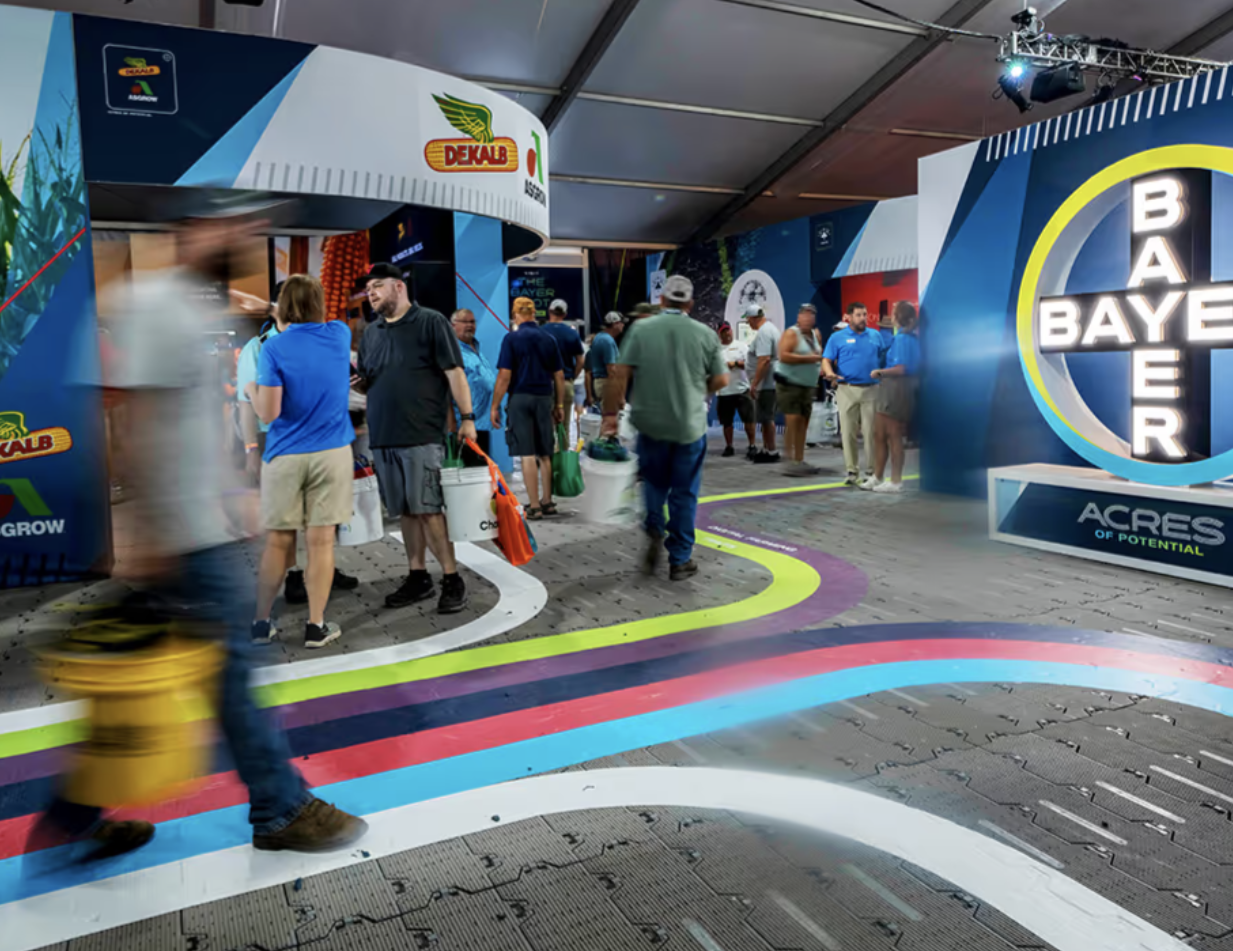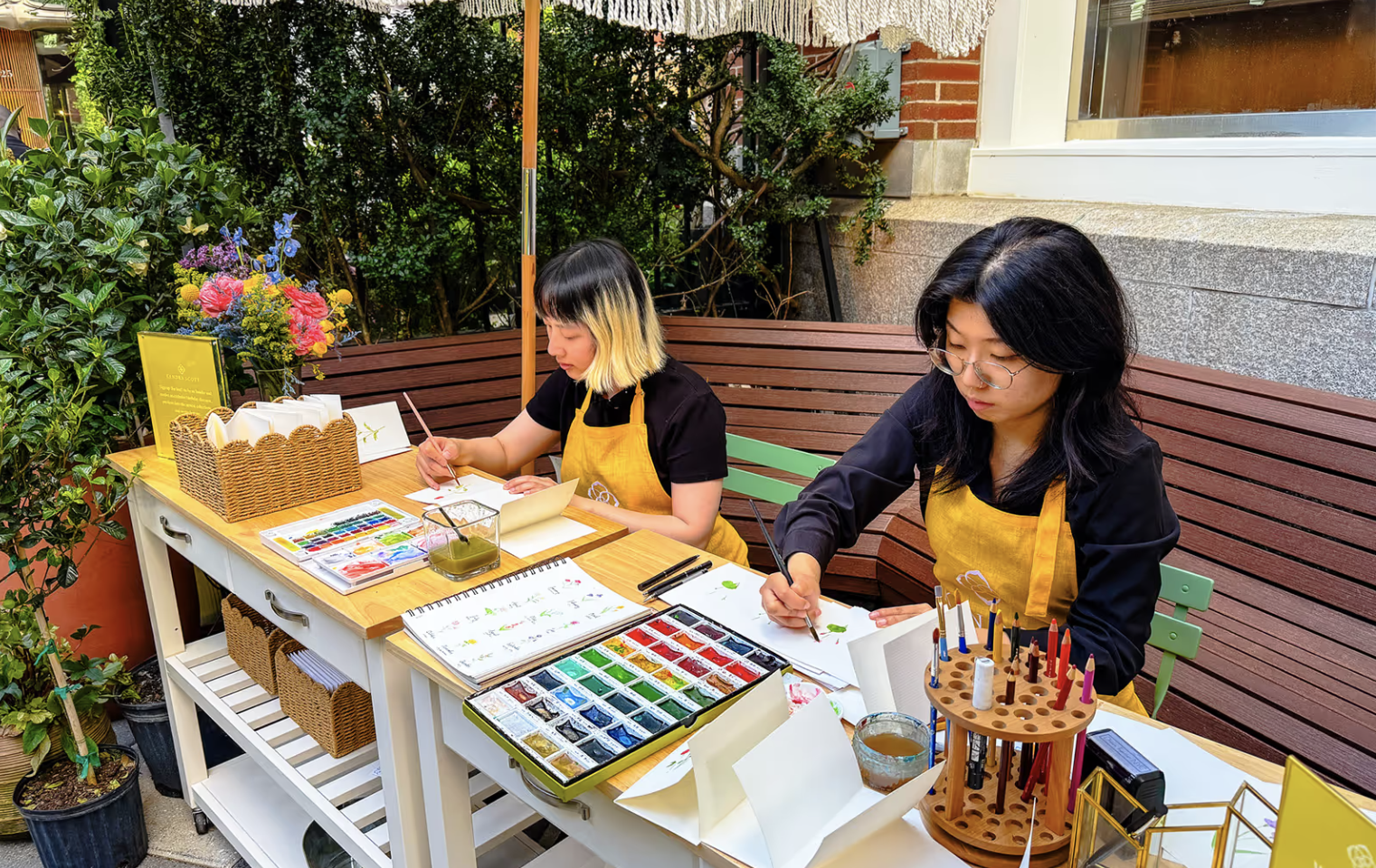Activation Visual Effects
Activation visual effects use projection mapping, interactive displays, and digital technology to create memorable brand experiences during live events, mobile tours, and pop-up installations. These visual technologies turn physical spaces into dynamic environments that capture audience attention and generate social media content through immersive brand storytelling. Brand activations integrate visual effects with custom fabrication, lighting design, and interactive elements to create experiences that audiences want to participate in and share online.
Get your team aligned and your timeline organized with an activation planning process that handles everything from custom fabrication to day-of execution.
Visual Design Elements for Brand Activations
Visual design elements create memorable brand experiences through custom fabrication, branded materials, and premium construction that captures audience attention during live events and mobile tours. In-house fabrication capabilities including laser etching, 3D printing, and woodworking produce unique branded components, signage systems, and display elements that reinforce brand identity while maintaining professional presentation standards. Custom fabricated visual elements provide cohesive brand experiences that photograph well for social media documentation:
Custom Fabrication for Branded Displays and Signage
Custom fabrication creates unique branded displays through laser etching, 3D printing, and woodworking capabilities that produce signage, product holders, and decorative elements for live events and mobile tours. In-house production allows precise brand integration across all visual components while maintaining quality control and customization options for different campaign requirements. Fabricated elements include branded displays, custom signage systems, product presentation platforms, and structural components that enhance visual presentation while supporting operational needs for audience engagement and product demonstration activities.
Mobile Tour Visual Branding and Vehicle Graphics
Mobile tour vehicles integrate visual branding through custom wraps, exterior graphics, and branded displays that create moving advertisements for brand campaigns. Vehicle design incorporates brand colors, logos, messaging, and visual elements while maintaining functionality for different tour stops and audience interaction requirements:
- Vehicle Wraps and Graphics: Full vehicle branding that incorporates brand colors, logos, and messaging while creating mobile advertisements for campaign visibility.
- Exterior Display Systems: Custom fabricated exterior elements that enhance vehicle presentation and provide branded touchpoints for audience interaction.
- Interior Branded Components: Custom fabricated displays, storage systems, and presentation elements that create cohesive brand experiences inside tour vehicles.
- Functional Design Integration: Visual branding that maintains operational requirements for sampling, demonstrations, and brand ambassador activities across tour locations.
- Transportation-Ready Construction: Durable fabrication that withstands travel conditions while maintaining visual impact throughout extended tour periods.
Document your brand activation with high-quality activation promotional videos that capture the energy and engagement your event generates.
Live Event Display Systems and Branded Environments
Live event display systems include custom fabricated backdrops, branded signage, product presentation platforms, and structural elements that create immersive brand environments for audience engagement. Display construction incorporates laser etched components, 3D printed elements, and premium materials that maintain visual impact while withstanding event conditions and transportation requirements. Custom fabrication supports event production with specialized displays, branded architectural elements, and presentation systems that enhance overall visual impact while accommodating specific venue requirements, audience flow patterns, and activation goals for different event types and locations.
Best Practices for Successful Brand Activation Planning
Successful brand activations require careful planning that considers venue conditions, audience behavior, and logistics requirements throughout the design and execution process. Project management coordinates fabrication teams, event production staff, and logistics specialists to deliver experiences that meet campaign objectives while maintaining safety standards. Performance testing validates custom fabricated elements and operational workflows before public deployment:
Event Setup and Production Considerations
Event setup procedures account for venue-specific factors including power availability, space limitations, and audience safety requirements that affect activation performance. Production workflows coordinate element delivery, installation, and testing within venue availability windows:
• Site Surveys: Identifying logistical challenges, power requirements, and contingency plans for weather or operational issues affecting activations.
• Load-In Coordination: Managing equipment transportation, setup timing, and quality control processes to ensure activations meet brand standards.
• Installation Procedures: Custom fabricated element delivery and setup protocols that account for venue limitations and safety requirements.
• Documentation Protocols: Recording setup procedures, display configurations, and performance metrics for future reference and process improvement.
• Strike Planning: Equipment removal and transportation while protecting venue properties and maintaining professional relationships.
Content Strategy and Brand Messaging Integration
Content strategy for brand activations balances brand messaging with engaging experiences to create memorable moments that communicate specific campaign objectives. Visual storytelling uses custom-fabricated elements, branded displays, and spatial design to guide audience attention through planned brand narratives. Brand integration incorporates logos, colors, and messaging into displays and event environments while maintaining experiential elements that capture audience interest.
Measuring Audience Engagement and Campaign Effectiveness
Engagement measurement tracks participant attendance, interaction frequency, and social media content generation to quantify campaign impact and audience response. Performance monitoring tracks foot traffic patterns, sampling distribution, and audience behavior to identify popular activation zones. Social media monitoring captures participant-generated content, measures reach and engagement rates, and tracks brand mention volume during and after events to determine return on investment. These campaigns show how different packaging approaches and execution methods affect audience response and content creation:
- Checkers "Fry-Seasoned" Campaign: Black and white checkered packaging with red branding created instantly recognizable unboxing experiences that aligned with the restaurant brand identity, using bold graphics and branded merchandise to generate social media content focused on the distinctive packaging design.
- Bayer Farm Progress Show: A 2.25-acre outdoor experience featured shipping container merchandise stores, LED bar bikes, and backlit technology kiosks that engaged families through educational content and live entertainment.
- Benjamin Moore Contractor Appreciation Tour: A branded vehicle traveled to contractor locations, delivering appreciation gifts while building business relationships through mobile brand visibility.
- Kendra Scott Mother's Day Pop-Up: Custom fixtures with oversized florals and natural elements in New York City created photo-worthy moments that drove social media sharing through thoughtful product displays.




Equipment Safety and Event Compliance Requirements
Equipment safety and event compliance protect participants and staff during brand activations through established protocols that meet local regulations and industry standards. Safety planning addresses custom fabricated element installation, crowd management, and emergency procedures for different venue types and audience sizes:
Safety Protocols for Custom Fabricated Elements
Safety protocols for custom fabricated displays include structural integrity testing, secure mounting procedures, and regular inspection schedules that prevent equipment failure during public events. Electrical safety procedures cover power distribution, grounding requirements, and backup systems that maintain safe operations while protecting participants from electrical hazards.
Event Compliance and Regulatory Requirements
Event compliance includes permit acquisition, insurance requirements, and regulatory coordination with venue management and local authorities to maintain legal operations across different markets. Crowd management protocols establish audience flow patterns, capacity limits, and emergency evacuation procedures that account for different venue layouts:
- Permit Acquisition: Securing required permits for different venue types, local jurisdictions, and activation formats before tour deployment.
- Insurance Requirements: Maintaining comprehensive coverage that protects against liability, equipment damage, and operational disruptions.
- Venue Coordination: Working with venue management to meet specific safety requirements, capacity limits, and operational guidelines.
- Emergency Procedures: Establishing evacuation plans, emergency contacts, and incident response protocols for different activation scenarios.
- Regulatory Compliance: Meeting local regulations for public gatherings, food handling, product sampling, and promotional activities.
Tour Logistics and Transportation Management
Tour logistics coordinate mobile tour operations across multiple markets through systematic planning that accounts for route optimization, equipment transportation, and local regulatory requirements. Transportation planning includes vehicle maintenance schedules, driver certification requirements, and cargo securing procedures that protect custom fabricated elements during transit between tour stops:
Route Planning and Market Coordination
Route planning optimizes tour timing to maximize audience exposure while accommodating local events, weather considerations, and venue availability that might affect activation effectiveness. Market coordination includes permit acquisition, parking arrangements, and utility access that support tour operations while maintaining compliance with different municipal requirements and venue-specific regulations across tour markets.
Equipment Transportation and Inventory Management
Equipment inventory management tracks custom fabricated elements, branded materials, and operational supplies across multiple tour stops while maintaining quality control and replacement procedures. Transportation procedures ensure equipment arrives intact and on schedule for each tour stop:
- Cargo Securing Procedures: Proper loading and securing techniques that protect custom fabricated displays during transit between markets.
- Inventory Tracking Systems: Documentation that monitors equipment condition, location, and availability throughout extended tour periods.
- Quality Control Inspections: Regular equipment checks that identify damage, wear, or missing components before public deployment.
- Replacement Protocols: Procedures for sourcing and delivering replacement components to maintain tour operations and brand presentation standards.
- Transit Protection Methods: Packaging and cushioning systems that prevent damage to laser etched, 3D printed, and custom fabricated elements during transportation.
Activation Visual Effects Production by Activate
Activate creates activation visual effects through custom fabrication capabilities, live event production services, and specialized equipment including laser etching and 3D printing that support projection mapping installations. Our in-house production team manages technical setup, content development, and calibration services from our Detroit facility while coordinating on-site installation and operation for events nationwide.
Ready to create memorable activation visual effects for your brand? Contact Activate to discuss projection mapping solutions, interactive installations, and visual technology integration that delivers measurable audience engagement and social media impact.
Frequently Asked Questions
How long does custom fabrication take for brand activations?
Custom fabrication timelines depend on design complexity, material requirements, and production scheduling for laser etching, 3D printing, and woodworking projects. In-house fabrication capabilities allow for expedited production when needed, with projects typically completed within established timeframes that accommodate event schedules and campaign launch dates.
What materials can be used for custom displays and signage?
Custom displays and signage can be created using wood, metal, plastic, and composite materials that support laser etching, 3D printing, and traditional fabrication techniques. Material selection depends on venue requirements, durability needs, and brand aesthetic preferences, with options ranging from premium finishes for high-end events to weather-resistant materials for outdoor activations.
Do mobile tours require special permits or regulations?
Mobile tours require various permits and regulatory compliance depending on tour routes, vehicle specifications, and local jurisdiction requirements. Tour planning includes permit acquisition, route coordination, and regulatory compliance management to ensure smooth operations across different markets while maintaining legal requirements and venue access.
